Hacia la ciudad creativa
##plugins.themes.bootstrap3.article.main##
Resum
Hi ha ciutats que desborden talent com una selva tropical i altres que viuen en l’erm o es conformen amb ser oasi enmig del desert. La creativitat col·lectiva, com la personalitat individual, naix i es fa. Hi ha llocs en els quals els seus habitants disposen de temps i predisposició (a causa del rigor del clima) per a atresorar saviesa i destresa en la soledat del foc, i de fet així es comporten, però no obstant això són incapaços de plasmar després aqueix coneixement en un bé cultural; i hi ha uns altres les poblacions del qual viuen majorment al carrer (degut també al clima) i creen art sense saber-ho quan es disposen a contar un acudit o a mirar les estreles. Les raons per les quals un determinat saber, tècnica o intuïció es converteix en producte cultural són difuses i en tot cas prolixes. El que és clar és que hi ha administracions que no arriben a gestionar les llums desbordants de la seua ciutadania i altres als qui els sobra el pressupost anual de Cultura.
Descàrregues
##plugins.themes.bootstrap3.article.details##

Aquesta obra està sota una llicència internacional Creative Commons Reconeixement-NoComercial-SenseObraDerivada 4.0.
.png)
Tots els continguts de la revista kult-ur se distribueixen sota una llicència d'ús i distribució Creative Commons Atribució-Compartir Igual 4.0 Internacional (CC BY-SA 4.0), excepte indicació contrària. Pot consultar ací la versió informativa i el text legal de la llicència. La indicació de la llicència d'ús i distribució CC BY-SA 4.0 ha de constar expresament d'aquesta manera quan siga necessari.
Referències
Florida, R. 2006. «“More on Cultivating Creativity”.» CATO Unbound. A Journal of Debate https://www.cato-unbound.org/2006/06/14/richard-florida/more-cultivating-creativity/.
Florida, R. 2010. La clase creativa. Madrid: Paidós.
Herrera, E; Molina-Prieto, L.F; Bonilla, H. 2013. «“Ciudades creativas: ¿paradigma económico para el diseño y la planeación urbana?» Bitácora22 (Universidad Nacional de Colombia) 1: 11-20.
Landry, C. 2000. The Creative City. A toolkit for Urban Innovation. Londres: Earthscan.
UNESCO. 2001. «Declaración Universal de la UNESCO sobre la Diversidad Cultural.» París: UNESCO.


